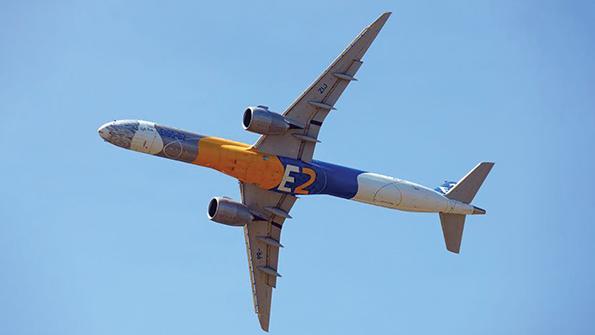
Embraer’s next generation of more fuel-efficient E-Jets for the medium-range aircraft market began in earnest with the entry into service of the E190-E2 in April 2018.
In late 2019, its larger E195-E2 aircraft variant entered service, while the smaller E175-E2 still awaits launch. Coming just a few months before the start of the COVID-19 pandemic, the program’s subsequent momentum has inevitably been slowed, but it is the E195-E2 that has accounted for the largest number of in-service aircraft to date.
The E195-E2 is viewed as a direct competitor to the Airbus A220-300 program—known as the Bombardier C Series-300 before its acquisition by Airbus in 2018—and has been deemed by some analysts as underperforming so far in terms of sales. Fewer E195-E2s are in service than E190-E2s, too. However, the E195-E2 has seen several key orders in the past year, in line with the relatively faster recovery of the regional aircraft market.
Aviation Week’s Fleet & MRO Forecast estimates that 64 E195-E2 aircraft will be in service this year. KLM Royal Dutch Airlines will operate the highest number, with 13 aircraft anticipated in its fleet this year. Launch customer Azul Brazilian Airlines will follow with 11 aircraft, all on lease from AerCap.
The fleet is expected to grow steadily over the decade: Aviation Week estimates that it will be 22.3% larger by 2031. Regional operators in the Americas and Europe are expected to drive this growth. Canadian carrier Porter Airlines ordered 30 E195-E2s in the summer of 2021, with options for a further 50 aircraft. Latin America will account for the largest fleet volumes by the mid-2020s, and that region will have the greatest number of aircraft by 2031, with approximately 169 units, according to Aviation Week.
In 2022, the fledgling aircraft program’s MRO market is valued at $27.3 million by Aviation Week. Given the recent entry into service of the type, maintenance on it this year will consist of a 50-50 split of line maintenance and component repairs. Over the next 10 years, Aviation Week data forecasts that overall MRO spending will grow by 32% as more aircraft enter service and increased demand builds for parts and line maintenance as well as engine MRO, airframe heavy maintenance and modifications.
In readiness for the growing aftermarket, some MRO providers have begun adding maintenance capabilities for the E195-E2 in the past year. OGMA, a member of Pratt & Whitney’s GTF MRO network, added repair capabilities for the aircraft’s PW1900G engine, a derivative of the PW1000G family. Meanwhile, StandardAero told Aviation Week last year that Embraer had asked it to participate in engine line-replaceable unit opportunities on its E-Jet E2 family.
In the midterm, component repairs will drive the future of the segment. Up until 2027, parts maintenance will be the largest segment of the overall MRO spending for the type.
Since the proposed (but now terminated) joint venture with Boeing nearly two years ago—an 80-20% partnership that would have seen the hypothetical company Boeing Brasil take charge of the E-Jet program—Embraer has integrated commercial maintenance into its services and support division.
The Brazilian OEM has leaned toward arranging pooling agreements for components with operators, as signified by its October 2021 agreement with KLM Cityhopper. This carrier, the regional subsidiary of KLM Royal Dutch Airlines, received its first E195-E2 last year and has a total of 25 aircraft on order.
Engine maintenance, which typically accounts for the biggest share of an aircraft program’s MRO spending, will start to pick up by the mid-2020s for the E195-E2 as shop visits start to materialize. Centered on the PW1900G, the engine will begin generating the biggest MRO volume by 2028, when it is expected to overtake component MRO to garner a 53% share of the E195-E2 aftermarket, generating $176.8 million.
Latin America will have the largest share of the future MRO market—reflecting its dominance in future fleet numbers. Aviation Week estimates that in 2031 Latin America will generate $783.6 million in annual MRO spending. This is followed by Western Europe, expected to account for $751.8 million, and Africa at $365 million.





